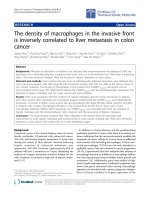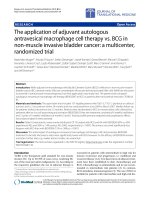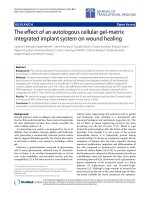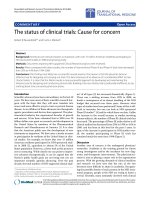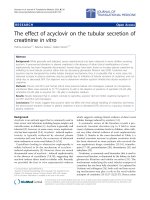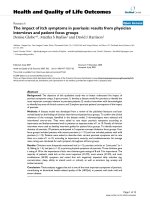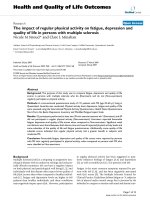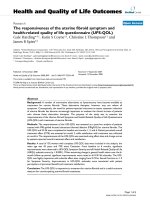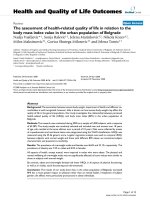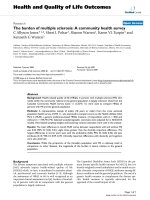báo cáo hóa học:" The integrated care pathway reduced the number of hospital days by half: a prospective comparative study of patients with acute hip fracture" doc
Bạn đang xem bản rút gọn của tài liệu. Xem và tải ngay bản đầy đủ của tài liệu tại đây (245.18 KB, 7 trang )
BioMed Central
Page 1 of 7
(page number not for citation purposes)
Journal of Orthopaedic Surgery and
Research
Open Access
Research article
The integrated care pathway reduced the number of hospital days
by half: a prospective comparative study of patients with acute hip
fracture
Lars-Eric Olsson*
1,2
, Jón Karlsson
2
and Inger Ekman
1
Address:
1
Sahlgrenska Academy at Göteborg University, Institute of Health and Care Sciences, Göteborg, Sweden and
2
Orthopaedic Department,
Sahlgrenska University Hospital/Östra, Göteborg, Sweden
Email: Lars-Eric Olsson* - ; Jón Karlsson - ; Inger Ekman -
* Corresponding author
Abstract
Background: The incidence of hip fracture is expected to increase during the coming years,
demanding greater resources and improved effectiveness on this group of patients. The aim of the
present study was to evaluate the effectiveness of an integrated care pathway (ICP) in patients with
an acute fracture of the hip.
Methods: A nonrandomized prospective study comparing a consecutive series of patients treated
by the conventional pathway to a newer intervention. 112 independently living patients aged 65
years or older admitted to the hospital with a hip fracture were consecutively selected. Exclusion
criteria were pathological fracture and severe cognitive impairment. An ICP was developed with
the intention of creating a care path with rapid pre-operative attention, increased continuity and
an accelerated training programme based on the individual patient's prerequisites and was used as
a guidance for each patient's tailored care in the intervention group (N = 56) The main outcome
measure was the length of hospital stay. Secondary outcomes were the amount of time from the
emergency room to the ward, to surgery and to first ambulation, as well as in-hospital
complications and 30-day readmission rate.
Results: The intervention group had a significantly shorter length of hospital stay (12.2 vs. 26.3
days; p < 0.000), a shorter time to first ambulation (41 vs. 49 h; p = 0.01), fewer pressure wounds
(8 vs. 19; p = 0.02) and medical complications (5 vs. 14; p = 0.003) than the comparison group. No
readmissions occurred within 30 days post-intervention in either group.
Conclusion: Implementing an ICP for patients with a hip fracture was found to significantly reduce
the length of hospital stay and improve the quality of care.
Background
Hip fractures represent an increasing health problem in
the Western world, mainly because the aging world's pop-
ulation. For instance, in the USA 350,000 incidents per
year occur [1] and in the European Union 500,000 per-
sons sustain a hip fracture per year [2]. In Sweden, the
number of persons with a hip fracture is 18,000 and
approximately 90% of them are over 65 years old, with
more than half being octogenarians [3]. The incidence of
hip fracture is expected to increase during the coming
Published: 25 September 2006
Journal of Orthopaedic Surgery and Research 2006, 1:3 doi:10.1186/1749-799X-1-3
Received: 30 March 2006
Accepted: 25 September 2006
This article is available from: />© 2006 Olsson et al; licensee BioMed Central Ltd.
This is an Open Access article distributed under the terms of the Creative Commons Attribution License ( />),
which permits unrestricted use, distribution, and reproduction in any medium, provided the original work is properly cited.
Journal of Orthopaedic Surgery and Research 2006, 1:3 />Page 2 of 7
(page number not for citation purposes)
years [4], demanding greater resources and improved
effectiveness on this group of patients. The challenge lies
in efficient use of the limited resources available to pro-
vide a high quality care based on clinical evidence.
Changes in health status involve a process of transition
[5]. Recovering from a hip fracture is a difficult period of
transition, as the majority of elderlys live an independent
life on the pre-morbid state while during the post-fracture
period, they have to struggle in order to regain their well-
being and pre-fracture functioning. Rehabilitation after a
hip fracture requires a major effort from the patients, and
other patients lost their independence [1,6,7]. Salkeld et
al. [8] found that any loss of ability to live independently
in the community has a considerable detrimental effect
on an individual's perceived quality of life.
We have recently shown that despite age and health status,
patients with a hip fracture had a strong will to recover,
although they used different strategies to engage in the
rehabilitation process [9]. These strategies must be identi-
fied by caregivers if successful rehabilitation is to be
attained. In addition to the patient motivation, the care of
patients with a hip fracture requires a team approach in
which the co-ordination between the various aspects of
care is important. Integrated care pathways (ICPs) have
been proposed as one means of providing high quality
care in a timely and cost-effective manner [10,11]. ICPs,
which are used in many hospitals in several countries [12-
16], have been described for over 45 conditions/proce-
dures [17], including hip and knee replacement surgery
and hip fractures. The degree to which they have suc-
ceeded in realising this potential for improving patient
care has not been established, but there is enough sup-
porting evidence to justify further research [17].
The aim of the present study was to evaluate the effective-
ness of an ICP in patients with an acute fracture of the hip.
The main outcome measure was the length of hospital
stay; secondary outcomes were time from admission to
the ward, operation, first ambulation, in-hospital compli-
cations and 30-day readmission. It was hypothesised that
by coordinating and individualising the care path from
admission to first ambulation and implementing a struc-
tured controlled training program it would be possible to
reduce length of hospital stay and to decrease the number
of medical complications.
Methods
Study design and procedures
A nonrandomized prospective study was conducted com-
paring an intervention group, guided by an ICP, with a
comparison group, representing standard care [18]. The
comparison group included 56 patients admitted to hos-
pital between October 2003 and March 2004 and was
compared with the intervention group by pre-fracture
data regarding demographics, physical function and med-
ical and mental status. The ICP was subsequently devel-
oped and implemented. All concerned personnel received
special training and instructions for the successful imple-
mentation of an ICP. Data were then collected from 56
consecutive patients in the intervention group between
October 2004 and March 2005. The patients received
both oral and written information about the study at
admission and informed consent was obtained from each
patient. Participants in the study were only required to
approve the use of their pre-fracture and clinical data. The
study was approved by the human research ethics com-
mittee at the Medical Faculty, Göteborg University (Ö-
420-03).
Sample size
A previously conducted audit of hospital records of
patients with a hip fracture indicated that the mean length
of hospital stay was 31 days (SD 14.5) [19]. We estimated
that 53 patients would be required in each group to
achieve 80% power for detecting an 8-day reduction in
length of hospital stay at a significance level of p < 0.05.
Patient selection
Independently living ambulatory patients (with or with-
out assistive devices) 65 years or older admitted to the
hospital with an acute hip fracture were consecutively
selected. Exclusion criteria were pathological fracture and
severe cognitive impairment as assessed by the Short Port-
able Mental Status Questionnaire (SPMSQ) [20]. Approx-
imately 35% of the patients in each group were excluded
because of a low Pfeiffer test score. All eligible patients
agreed to participate in the study. Three patients in the
comparison group died before discharge from hospital.
Data collection
All patients were interviewed by a nurse and demographic
information was gathered on age, social status, type of liv-
ing and degree of independence before the fracture using
the Functional Recovery Scale (FRS) [21,22]. The physi-
cian who admitted the patient asked about co-morbidities
and drugs while the interviewing nurse assessed the
patients' nutritional status and symptoms of other poten-
tial problematic areas. At discharge, the patients' depend-
ency on a walking aid and gait capacity was measured in
order to determine their physical functioning upon leav-
ing the hospital. Standard care consisted of a transferral
system in which patients could be transferred to a geriatric
department in hospital in order to facilitate post-operative
rehabilitation. Decisions on which patients to transfer
were made within the first few days after admission by an
orthopaedic surgeon. Altogether, 28 patients were trans-
ferred.
Journal of Orthopaedic Surgery and Research 2006, 1:3 />Page 3 of 7
(page number not for citation purposes)
The intervention
The intervention was developed with the intention of cre-
ating a care path with rapid pre-operative attention,
increased continuity and an accelerated training pro-
gramme without disturbing the flow of patients with
other diagnoses. ICP documentation was developed in the
form of a check list that displayed what to do and when to
do it. Furthermore, the ICP covered all the critical ele-
ments of care and rehabilitation. The discharge plan,
based on the patients' pre-fracture functioning, was devel-
oped within the first 48 h after admission. Long-term
goals and intermediate goals were discussed with the
patients' and their relatives in order to obtain a spirit of
understanding. The nurses collaborated with the patients
and their families throughout the hospital stay and were
responsible in arranging contact with the communities'
help service to secure the necessary training and support.
As a part of the intervention, patients in the intervention
group were transferred for medical reasons only and
remained on the orthopaedic ward until they had attained
an ADL level equivalent to their pre-fracture level, or until
they did not progress further in their rehabilitation. No
patient in the intervention group was transferred to other
wards.
Before the start of the intervention, staff in the emergency
room and radiology department was encouraged to attend
and treat these patients rapidly so they could be admitted
to the ward and prepared for surgery as soon as possible.
Post-operatively, the earliest first ambulation was encour-
aged (if possible, the same day or the next morning). The
training was then increased in accordance with the indi-
vidual patient's prerequisites, although balancing
between training and rest. Common rehabilitation inter-
ventions include providing advice, training, encourage-
ment and listening to patients' concerns as well as drug
treatment, physiotherapy, occupational therapy and help
with use of appliances, equipment and daily living aids
(Figures 1 and 2).
Statistics
Parametric data were analysed with Student's t-test for
independent groups while non-parametric data were ana-
lysed using Fisher's exact test and Chi-Square. Statistical
significance was set to p < 0.05
Results
The two study groups did not differ in any of the pre-frac-
ture demographic variables (Table 1). The mean length of
hospital stay was 26.3 days (SD 17.0) in the comparison
group vs. 12.2 days (SD 3.5) in the intervention group (p
< 0.000).
Time spent at the different pre-operative ICP steps was
measured and compared. The intervention group spent
less time waiting at the emergency room before receiving
care on the ward as compared with the control group (4
vs. 5 h; p = 0.02) and less time waiting for surgery (22 vs.
23 h; p = 0.6, ns)
The intervention group spent significantly less time
between surgery to first ambulation (20 h vs. 28 h; p <
0.000), as well as from arrival to hospital to first ambula-
tion (41 h, SD 13.2 vs. 49 h, SD 19.2; p = 0.01).
Contrary to the comparison group, significantly fewer
patients in the intervention group developed complica-
tions: pressure wounds (8 vs. 19 patients; p = 0.02) and
medical complications (5 vs. 14 patients; p = 0.003)
Data on physical functioning, ambulatory capacity and
dependency on walking aids at discharge are shown in
Tables 2 and 3. A non-significant difference in discharge
destination was found in which 37 of the patients in the
comparison group vs. 42 in the intervention group
returned to their former place of residence (p = 0.517).
There were no fracture-related readmissions within 30
days from discharge in either group.
Discussion
The present study showed that our ICP was associated
with a significantly shorter hospital stay, i.e. the number
of care days was reduced by half compared with the com-
parison group. Despite a shorter hospital stay, the inter-
Comparison groupFigure 1
Comparison group. Clinical trajectory of care in the compar-
ison group.
living
3 pat died
13 pat
Ward
FormerCommunity
facility
Geriatric
ward
War
d
Operating
theater
Radiation
Dept.
Emergency
room
28 pat
24pat
56 pat
15pat
1 pat
Journal of Orthopaedic Surgery and Research 2006, 1:3 />Page 4 of 7
(page number not for citation purposes)
vention group had better physical functioning and a
higher ADL level. In the intervention group 25% more
patients reached or approached their pre-fracture ADL
level. Moreover, the intervention group was less depend-
ent on walking aids, equal in gait capacity and more of the
intervention patients returned to their former residence
(Figures 1 and 2). These latter differences approached sta-
tistical significance and would likely have reached signifi-
cance with a larger patient sample. A noteworthy fact was
that it was possible to achieve this result without allowing
a running-in period.
The randomised controlled trial design is considered the
gold standard for evaluating interventions; however, its
use in studies of this kind is somewhat problematic
because such a design involves interactions between the
patients and nurses. If two wards are used, it is difficult to
know whether it was the change of actions or the interac-
tions between the nurses and patients that contributed to
any differences. In most studies a before-and-after design
is preferred. The present study was carried out using a
nonrandomized prospective design in which an interven-
tion group was compared with a standard care group [18].
A disadvantage of this design is that it precludes conclu-
sions regarding the true effects of an intervention, i.e. to
know whether between-group differences are due to the
intervention or to other factors. However, most studies of
ICPs in patients with hip fractures have been conducted
using this method [13-16].
The results of the present study are largely consistent with
those reported in similar studies of ICPs in patients with a
hip fracture [13,14,16,23]. In a controlled, prospective
study Choong et al. [13] found that ICPs reduced the
length of hospital stay without increasing the risk of com-
plication or readmission rates. In another study Tarling et
al. [16] noted that ICPs could reduce the length of hospi-
tal stay by 33%. Similarly, in a study comparing a fast
track group to an ICP group Gholve et al. [14] found that
ICPs could reduce the length of hospital stay by four days.
On the other hand, Roberts et al. [15] found that whereas
hospital stay increased, the quality of care was improved.
ICPs, which are designed to streamline and standardise
various aspects of patient care, are structured multidisci-
plinary care protocols defining and specifying critical
steps and progress in the care of various patient groups
[24]. In implementing an ICP for acute hip fractures the
most difficult component of the care trajectory in which
to affect change are the steps from admission to first
ambulation because so many different professionals are
involved. Several studies have shown a correlation
between waiting time for surgery and prolonged hospital
stay [25,26], usually stating that more than 48 h of wait-
ing will increase the hospital stay. In one study it was
found that when the waiting time increased from 9 h to 16
h, the hospital stay increased by 19% [27]. It appears rea-
sonable to keep the waiting time short because patient
suffering can be relieved and precious time will be saved.
For this reason, we made concerted efforts here and
accomplished significant changes in two out of three out-
comes. The continuity of caregivers and care content was
maintained simply by eliminating transfers for other than
medical reasons. Consequently, no transfers were made in
the intervention group.
When the ICP protocol in the present study was devel-
oped, it was decided to build on the patients' engagement
from an earlier study [9]. The hospital period is only the
beginning of the rehabilitation process and it is important
to facilitate a healthy transition process. In contrast to the
care of younger patients, the care of elderly patients is
more complex with more factors involved (such as health
status, co-morbidities, motivation and cognitive function-
ing). It was believed that early improvements in the care
Intervention groupFigure 2
Intervention group. Clinical trajectory of care in the inter-
vention group.
living
Emergency
room
Community
facility
Former
Ward
War
d
Operating
theater
Radiation
Dept.
43 pat 13 pat
56 pat
Journal of Orthopaedic Surgery and Research 2006, 1:3 />Page 5 of 7
(page number not for citation purposes)
Table 1: Baseline data.
Data Comparison N = 56 Intervention N = 56 P-value Data Comparison N = 56 Intervention N = 56 P-value
Female/male 42/14 41/15 1.0 Type of living
Mean age 84 84 Flat 31 37 0.3
SD (7.0) (6.9) 0.9 House 13 7
Service flat 12 12
Living
With someone 19 14 Need of home help services
Alone 37 42 0.4 None 34 28 0.4
Once a week 7 9
Daily 15 19
Place of accident Type of walking aid
At home 41 43 0.8 None 27 22 0.3
Outside home 15 13 Stick 11 8
Walking frame 18 26
Number of co-morbidities Gait capacity •
Mean 2 3 Walking outdoors alone 31 26 0.4
Range (0–8) (0–8) 0.3 Walking outdoors with assistance 9 11
Walking indoors alone 13 13
Walking indoors with assistance 2 6
General medical health† Cognitive functioning at admission††
A1050.1Mean870.4
B 33 29 Median 9 8
C 13 22 Range (3–10) (3–10)
Intra-capsular fracture 29 21 0.1 Pre-fracture independence†††•
Hemiartroplasty 28 18 80 – 100 % 36 35 0.3
Osteosynthesis with 1 3 60 – 79 % 13 10
Two parallel nails < 60 % 6 11
Extra capsular fracture 27 35 Mean 84 82
SD (16.5) (23.1)
Data on pre-fracture and admission status are from the patients in both groups. There were no differences in pre-fracture demographics between the two groups.
• Missing data. Three patients died in the comparison group. Their available data were used.
† Ceder scale.
†† Pfeiffer's test.
††† Functional Recovery Scale.
Journal of Orthopaedic Surgery and Research 2006, 1:3 />Page 6 of 7
(page number not for citation purposes)
path may start a positive chain reaction that can be kept
going. An example is the earliest first ambulation that was
planned either on the day of surgery or the next morning.
Thus, the aim was to achieve a daily progress, which could
be accomplished by being sensitive to the patients'
resources (such as motivation) as well as being aware of
physical limitations, i.e. ensuring a balance between train-
ing and rest. The early mobilisation and the strict training
protocol reduced the number of pressure wounds. More-
over, the caregivers focused attention on each patient's
status may have played a role in reducing the number of
medical complications. In addition, early ambulation
probably helped the patients to realise that they would be
able to fully regain their ability to walk and thus their
autonomy at an earlier stage.
Conclusion
The ICP in the present study was effective. Although a sig-
nificant reduction of time to first ambulation was
achieved, the greatest effect was due to the care and atten-
tion given to the patients. Further investigation is needed
to illuminate what components of the ICP are responsible
for this reduction in care days and to determine whether
there is an effect on one-year survival.
Competing interests
The author(s) declare that they have no competing inter-
ests.
Authors' contributions
LEO, JK, IE contributed to the development of the study
protocol, design, data collection, statistical analysis, inter-
pretation of data and preparation of the manuscript. All
authors read and approved the final manuscript.
References
1. Morris AH, Zuckerman JD: National consensus conference on
improving the continuum of care for patients with hip frac-
ture. The Journal of Bone & Joint Surgery 2002, 4(84A):670-674.
2. Cumming RG, Nevitt MC, Cummings SR: Epidemiology of hip
fractures. Epidemiologic Reviews 1997, 19:244-257.
3. Thorngren KG: Rikshöft/SAHFE årsrapport 2001. Stockholm:
Socialstyrelsen 2002 [ />45C46EA7-A691-4AEF-B4CF-85C1AABFC53E/0/kva008r03.pdf].
4. Clague JE, Craddock E, Andrew G, Horan MA, Pendleton N: Predic-
tors of outcome following hip fracture. Admission time pre-
dicts length of stay and in-hospital mortality. Injury 2002,
33:1-6.
5. Meleis AI, Sawyer LM, Im E-O, Messias DKH, Schumacher K: Expe-
riencing Transitions: An emerging middle-range theory.
Advances in Nursing Science 2000, 1(23):12-28.
6. Egan M, Wairen SA, Hessel PA, Gilewish G: Activities of daily liv-
ing after hip fracture: Pre- and post discharge. The Occupa-
tional Therapy Journal of Research 1992, 12:342-356.
7. Marottoli RA, Berkman LR, Cooney LM: Decline in physical func-
tion following hip fracture. Journal of the American Geriatrics Society
1992, 40:861-866.
8. Salkeld G, Cameron ID, Cumming RG, Easter S, Seymour J, Kurrle SE,
Quine S: Quality of life related to fear of falling and hip frac-
ture in older women: a time trade off study. British Medical Jour-
nal 2000, 320:341-345.
9. Olsson L-E, Karlsson J, Ekman I: Admitted with a hip fracture:
patient perceptions of rehabilitation. Journal of Clinical Nursing
in press.
10. Dowsey MM, Kilgour ML, Santamaria NM, Choong PF: Clinical
pathways in hip and knee arthroplasty: a prospective, ran-
domised controlled study. Medical Journal of Australia 1999,
170:59-62.
Table 2: Physical functioning. The patients' physical functioning measured by basic-ADL pre-fracture and at discharge.
Pre-fracture Discharge
B-ADL Level Comparison N = 56 Intervention N = 56 Comparison N = 53• Intervention N = 56 P-value
A 38 34 2 7 0.003
B1282021
C 2658
D 2264
E 37
F26179
• Missing data. Three patients died in the comparison group.
Table 3: Gait capacity. Use of walking aids and ambulation capacity at discharge.
Walking aid Comparison N = 53 Intervention N = 56 P-value Distance Comparison N = 53 Intervention N = 56 P-value
None 1 0 0.02 10 meter 6 8 0.2
Walking stick 0 6 20 meter 4 4
Walking frame 43 37 30 meter 10 7
Walker 9 13 50 meter 3 11
100 meter 30 26
Publish with BioMed Central and every
scientist can read your work free of charge
"BioMed Central will be the most significant development for
disseminating the results of biomedical research in our lifetime."
Sir Paul Nurse, Cancer Research UK
Your research papers will be:
available free of charge to the entire biomedical community
peer reviewed and published immediately upon acceptance
cited in PubMed and archived on PubMed Central
yours — you keep the copyright
Submit your manuscript here:
/>BioMedcentral
Journal of Orthopaedic Surgery and Research 2006, 1:3 />Page 7 of 7
(page number not for citation purposes)
11. Zander K: Historical development of outcomes-based care
delivery. Critical Care Nursing Clinics of North America 1998,
1(10):1-11.
12. Cheah J: Development and implementation of a clinical path-
way programme in an acute care general hospital In Singa-
pore. International Journal for Quality in Health Care 2000,
5(12):403-412.
13. Choong PFM, Langford AK, Dowsey MM, Santamaoa NM: Pathway
for fractured neck of femur: a prospective, controlled study.
Medical Journal of Australia 2000, 172:423-6.
14. Gholve KA, Kosygan KP, Sturdee SW, Faraj AA: Multidisciplinary
integrated care pathway for fractured neck of femur: A pro-
spective trial with improved outcome. Injury 2005, 36:93-98.
15. Roberts HC, Pickering RM, Onslow E, Clancy M, Powell J, Roberts A,
Hughes K, Coulson D, Bray J: The effectiveness of implementing
a care pathway for femoral neck fracture in older people: a
prospective controlled before and after study. Age Ageing
2004, 33:178-184.
16. Tarling M, Aitken E, Lahoti O, Randall J, Skeete M, Wozniak R, Hen-
drie O, Hendrie T: Closing the loop: the role of a pilot in the
development of a fractured neck of femur integrated care
pathway. Journal of Orthopaedic Nursing 2002, 6:130-134.
17. Campbell H, Hotchkiss R, Bradshaw N, Porteous M: Integrated
care pathways. British Medical Journal 1998, 316:133-137.
18. Polit DF, Hungler BP: Nursing Research Principles and meth-
ods. 5th edition. Lippincott Company Philadephia; 1995.
19. Källström L: Effektivitet i SU-sjukvården – Granskningsre-
sultat av vårdkedjestudie våren 2000 (in Swedish). Revisionsen-
heten för Västra Götaland i Vänersborg Komrev AB 2000.
20. Pfeiffer E: A short portable mental status questionnaire for
the assessment of organic brain deficit in elderly patients.
Journal of American Geriatrician Society 1975, 23:433-441.
21. Zuckerman JD, Koval KJ, Aharonoff GB, Hiebert R, Skovron ML: A
functional recovery score for elderly hip fracture patients:
Development. Journal of Othopaedic Trauma 2000, 14:
20-25.
22. Zuckerman JD, Koval KJ, Aharonoff GB, Hiebert R, Skovron ML: A
functional recovery score for elderly hip fracture patients:
Validity and reliability. Journal of Othopaedic Trauma 2000,
14:26-30.
23. Atwal A, Caldwell K: Do multidisciplinary integrated care path-
ways improve interprofessional collaboration? Scandinavian
Journal of Caring Sciences 2002, 16:360-367.
24. Coffey RJ, Richards JS, Remmert CS, LeRoy SS, Schoville RR, Baldwin
PJ: An introduction to critical paths. Quality Management in
Health Care 1992, l:45-54.
25. Gdalevich M, Cohen D, Yosef D, Tauber C: Morbidity and mortal-
ity after hip fracture: the impact of operative delay. Archives
of Orthopaedic and Trauma Surgery 2004, 124:334-340.
26. Kamel HK, Iqbal MA, Mogallapu R, Maas D, Hoffmann RG: Time to
ambulation after hip fracture surgery: Relation to hospitali-
zation outcomes. Journal of Gerontology:MEDICAL SCIENCES 2003,
11(58A):1042-1045.
27. Thomas S, Ord J, Pailthorpe C: A study of waiting time for sur-
gery in elderly patients with hip fracture and subsequent in-
patient hospital stay. Annals of the Royal College of Surgeons of Eng-
land 2001, 83:37-39.
